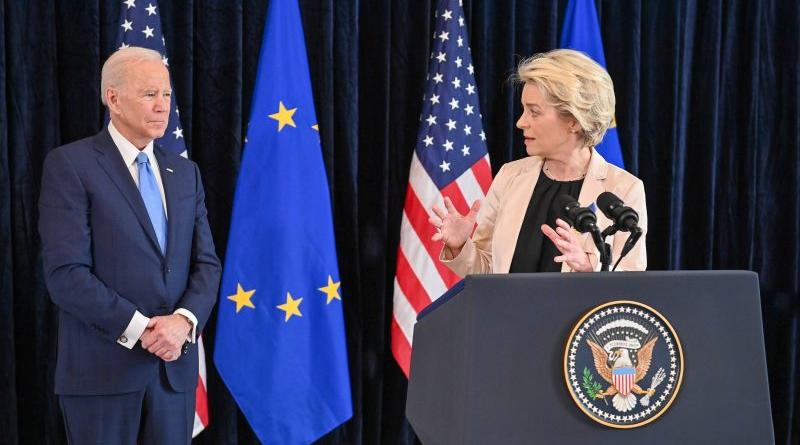How the US and the EU handle the present moment could have significant positive spillover effects for industrial decarbonisation around the world – and, as a result, international climate mitigation efforts, write Mary Hellmich and Sarah Jackson.
When the United States passed the Inflation Reduction Act (IRA) in August 2022, the world sighed with relief that the US passed a bona fide climate bill.
The legislation also, however, sparked international cries of protectionist foul play. Loud among the voices was the European Union, accusing its valued ally and trade partner of luring European business to American shores and raising fears of EU-wide deindustrialisation.
Half a year later the two sides are approaching a harmonious path forward, and the transatlantic space could be positioning itself to lead the world towards a green overhaul of the international trade regime.
Concerted efforts to find a solution from both sides reduced the post-IRA transatlantic trade tensions and ushered in a general spirit of cooperation.
After French President Macron’s visit to the White House in December 2022, long-time transatlanticist President Biden gave a display of diplomatic goodwill, opening the stringency of the IRA’s domestic content requirements – one of the main sticking points for the EU – to a softer interpretation and showing an openness to “tweak” the legislation in the bloc’s favour.
The President’s flexibility shows that, although his administration’s trade policy is similar to that of his predecessor, Biden is committed to at least being perceived as not wanting to upset key allies like the EU.
Biden’s diplomatic words materialised into a concrete outcome a few weeks later, when the US Treasury Department announced it would pursue an expansive interpretation of the term “free trade agreement” in its implementation of the IRA. This development is of great relevance to the EU, as certain funding provisions in the bill are only available to domestic producers or those in countries that have a free trade agreement with the US, which the EU does not.
This announcement by the Treasury Department, therefore, potentially paves the way for European-tailored exceptions. How much the US favours the EU in this interpretation will be known in March, when the Treasury releases a notice of proposed rulemaking plans.
Though an all-out trade dispute seems to have been avoided, the settling dust is revealing a new transatlantic industrial policy landscape. And it looks like it’s here to stay.
The European Commission recently came out with a “Green Deal Industrial Plan for the Net-Zero Age.” Designed to help the bloc stay competitive in the face of the large green subsidies in the US and China, the plan has four focal points: regulation, financing, skills and trade.
Importantly, the plan will adapt EU state aid rules so Member States can more easily fund their domestic companies to make green investments, raising concerns of fragmenting the single market and leading to unfair competition within the bloc as countries like Germany and France outspend less wealthy EU countries.
The EU will move forward with its new industrial policy plans regardless of the IRA wiggle room granted to it by the US Treasury Department. The domestic content requirements are only part of the bloc’s concerns – the sheer level of the US’s subsidies and the lack of spending caps, combined with soaring energy prices, are also causing European leaders to worry about investments leaving the bloc and potentially altering the international level playing field.
The IRA has uncovered fault lines within the European approach to decarbonisation. Policy signals and the market alone are insufficient not only for the bloc to stay competitive during its green transition. Regardless of any IRA implementation leeway it receives, the EU seems to have realised it needs to expand its climate policy model beyond target-setting and regulation to also embark on a real economic transformation. And with its new industrial plan, it seems to be doing just that.
What happens now that both the US and the EU have their own robust green industrial plans?
One exciting possibility would be cooperation between the two. In a speech at the World Economic Forum in Davos, European Commission President Ursula von der Leyen advocated for just that. Urging both sides to find a way to jointly benefit from their respective investments, von der Leyen promoted outcomes such as creating economies of scale across the Atlantic and setting common standards.
How the US and the EU handle the present moment could have significant positive spillover effects for industrial decarbonisation around the world – and, as a result, international climate mitigation efforts. As decarbonisation plans leave the policy toolbox and enter the real world, countries will need to ensure they can implement these plans without experiencing economic dislocation.
As a result, conflicts over trade, subsidisation and competition could become the norm, not the exception. Government action is expected to continue to disrupt business-as-usual trade in order to secure their countries’ share of new clean energy markets, but the clean energy market is not a shrinking pie, it’s a growing pie.
If the transatlantic relationship agreed on a shared set of rules around decarbonisation, green subsidies and trade protection – rules that account for a wide range of policies depending on each country’s political possibilities – future trade wars can be prevented.
And the rest of the world could benefit. The current situation presents an opportunity to revamp the rules-based system of international trade. Increasingly challenged by governments around the world, the global trade regime must be able to absorb the pending flurry of green subsidies and decarbonisation policies in a way that benefits all countries.
An international green industrial diplomatic strategy could accomplish just that. Though the US did not show initiative in exploring how the IRA could benefit third, and especially developing, countries, a unified transatlantic industrial plan could. And if the US won’t play ball, the EU can – and should – fill this void alone.






